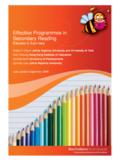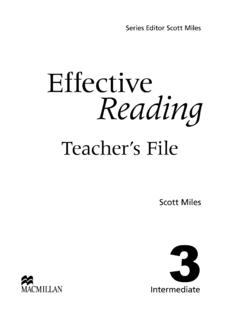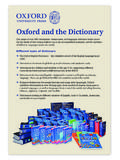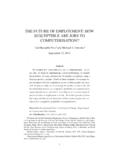Transcription of Effective Beginning Reading Programmes - Best …
1 Effective Beginning Reading Programmes Educator s Summary Robert E Slavin Johns Hopkins university and university of York Cynthia Lake Johns Hopkins university Bette Chambers university of York Alan Cheung Johns Hopkins university Susan Davis Success for All Foundation Last updated June 2009 During Key Stage 1 most children go through an extraordinary transformation as readers. If all goes well, by the end of Key Stage 1 they should know the sounds of all letters and be able to form them into words, know the most common sight words, and read and comprehend simple texts all the basic skills of turning print into meaning.
2 Success at this stage can be crucial to success in later years. As such there has been substantial research in the area, some of which has been highly influential. Recently, there has been a shift in policy and practice towards phonics and phonemic awareness in Beginning Reading instruction backed by high-profile reports, such as the Rose Review in the UK (2006) and a report by the US National Reading Panel (2000). This review summarises research on Beginning (non-remedial) Reading Programmes . We looked at all available evidence on Programmes designed to improve Beginning Reading achievement, in order to establish what we know works for primary pupils aged 5-7.
3 We examined all studies of Beginning Reading Programmes from all countries, as long as a report was available in English.* (NB Most studies took place in the US). We were then able to assess and compare the effectiveness of these Programmes . Descriptions and ratings for all the Programmes are listed further down this summary. The results of the review show that the most successful Programmes focus on changing daily teaching practices, such as the use of co-operative learning methods, and that Programmes that combine a focus on phonics with innovative teaching practices work best of all.
4 However, although the review highlighted the importance of using phonics, simply using books with more phonics or doing workshops on phonics is not enough to bring about widespread improvement in children's Reading . The full report (which this review summarises) is available at Instructional Process Programmes (IP) (Changing the way the teacher teaches, eg co-operative learning) Studies of Programmes that provide extensive professional development to help teachers use well-specified teaching methods showed relatively positive effects overall.
5 The mean weighted effect size across 17 studies was + , which means the difference between the achievement of children who were taught with these methods compared to children who were taught as usual. Particularly positive effects were found for co-operative learning (ES+ ), phonics-focused professional development (ES=+ ), and teaching of phonological awareness to 5 and 6 year-olds (ES=+ by the age of 7 or 8). Instructional Technology (IT) (Where technology is used to support Beginning Reading ) Studies of Instructional Technology found minimal effect sizes.
6 Mean weighted effect size across 13 studies: + Reading Curricula (Curr) (Textbooks) Studies of Reading curricula also found minimal effects of using particular textbooks. Mean weighted effect size across 7 studies: + Combined Curriculum and Instructional Process Programmes (Curr + IP) ( Programmes that both change how the teacher teaches, and include innovative curricula, eg Success for All and Direct Instruction) Our review found that Programmes that combine innovative phonetic materials with extensive professional development for teachers found positive effects overall.
7 In particular, positive effects were found for Success for All (ES= in 23 studies). *Overall, 63 experimental-control comparisons met the inclusion criteria, of which 19 used random assignment to treatments. Effect sizes (experimental-control differences as a proportion of a standard deviation) were averaged across studies, weighting by sample size. Effect sizes of more than + are considered educationally significant. programme Ratings Listed below are currently available Programmes , grouped by strength of effectiveness.
8 Within each group Programmes available in the UK are listed first, and then the remainder in alphabetical order. The type for each programme corresponds to the categories above (eg IP = Instructional Process Strategies). Key to programme Ratings Strong Evidence of Effectiveness: At least two studies, one of which is a large randomized or randomized quasi-experimental study, or multiple smaller studies, with a sample size-weighted effect size of at least + , and a collective sample size across all studies of 500 students or 20 classes.
9 Moderate Evidence of Effectiveness: At least one randomized or two matched studies of any qualifying design, with a collective sample size of 250 students or 10 classes, and a weighted mean effect size of at least + Limited Evidence of Effectiveness: Strong Evidence of Modest Effects: Studies meet the criteria for Moderate Evidence of Effectiveness except that the weighted mean effect size is + to + Limited Evidence of Effectiveness: Weak Evidence with Notable Effects: Studies have a weighted mean effect size of at least + , but do not qualify for moderate evidence of effectiveness due to insufficient numbers of studies or small sample sizes.
10 Insufficient Evidence of Effectiveness: One or more qualifying studies did not meet the criteria for Limited Evidence of Effectiveness . N No Qualifying Studies: No studies met inclusion standards Strong Evidence of Effectiveness Rating programme Type Description Contact / Website Success for All Curr + IP Provides schools with a Reading curriculum for pupils aged 5-11 that focuses on phonemic awareness, phonics, comprehension, and vocabulary development, Beginning with phonetically-controlled mini-books from the age of 5-7.









